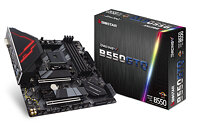- Joined
- Oct 9, 2007
- Messages
- 47,479 (7.49/day)
- Location
- Hyderabad, India
| System Name | RBMK-1000 |
|---|---|
| Processor | AMD Ryzen 7 5700G |
| Motherboard | ASUS ROG Strix B450-E Gaming |
| Cooling | DeepCool Gammax L240 V2 |
| Memory | 2x 8GB G.Skill Sniper X |
| Video Card(s) | Palit GeForce RTX 2080 SUPER GameRock |
| Storage | Western Digital Black NVMe 512GB |
| Display(s) | BenQ 1440p 60 Hz 27-inch |
| Case | Corsair Carbide 100R |
| Audio Device(s) | ASUS SupremeFX S1220A |
| Power Supply | Cooler Master MWE Gold 650W |
| Mouse | ASUS ROG Strix Impact |
| Keyboard | Gamdias Hermes E2 |
| Software | Windows 11 Pro |
AMD's 4th generation Ryzen "Renoir" desktop APUs, based on the "Zen 2" microarchitecture, could lack PCI-Express gen 4.0, hints the product page of an upcoming AMD B550 chipset motherboard by BIOSTAR. AMD already declared that the B550 lacks support for "Picasso," which means the "Ryzen with Radeon Vega Graphics" processors referenced in the BIOSTAR product page have to be "Renoir." On the mobile platform, Ryzen 4000H and 4000U series processors do lack PCIe gen 4.0, but it was expected that AMD will enable gen 4.0 for the desktop socket AM4 platform.
The lack of gen 4.0 support has implications for "Renoir." For starters, the APU, like its predecessors, spares only 8 PCIe lanes toward PEG (PCI-Express discrete graphics, or the main x16 slot you typically use for graphics cards). If these lanes are gen 3.0, then even the newer graphics cards, such as AMD's "Navi" RX 5700 XT, or next-gen GeForce "Ampere," would have to make do with a PCI-Express 3.0 x8 interface, despite being gen 4.0 x16-capable. We will test just how much of a bottleneck this poses, when the next-gen graphics cards come out.


The second implication specifically affects the platform. On some upcoming motherboards, such as the B550 AORUS Master by GIGABYTE, PCIe gen 4.0 lanes from the PEG slot are shared with a couple of additional M.2 slots. So, you'd be left with only one of the three M.2 slots functional, the topmost one that's directly wired to the AM4 socket, and at gen 3.0 speeds. Lastly, the lack of gen 4.0 means that the chipset-bus between "Renoir" and both the B550 and X570 will be PCI-Express 3.0 x4. With "Matisse" or "Vermeer," the bus runs at PCI-Express 4.0 x4 speeds.
View at TechPowerUp Main Site
The lack of gen 4.0 support has implications for "Renoir." For starters, the APU, like its predecessors, spares only 8 PCIe lanes toward PEG (PCI-Express discrete graphics, or the main x16 slot you typically use for graphics cards). If these lanes are gen 3.0, then even the newer graphics cards, such as AMD's "Navi" RX 5700 XT, or next-gen GeForce "Ampere," would have to make do with a PCI-Express 3.0 x8 interface, despite being gen 4.0 x16-capable. We will test just how much of a bottleneck this poses, when the next-gen graphics cards come out.


The second implication specifically affects the platform. On some upcoming motherboards, such as the B550 AORUS Master by GIGABYTE, PCIe gen 4.0 lanes from the PEG slot are shared with a couple of additional M.2 slots. So, you'd be left with only one of the three M.2 slots functional, the topmost one that's directly wired to the AM4 socket, and at gen 3.0 speeds. Lastly, the lack of gen 4.0 means that the chipset-bus between "Renoir" and both the B550 and X570 will be PCI-Express 3.0 x4. With "Matisse" or "Vermeer," the bus runs at PCI-Express 4.0 x4 speeds.
View at TechPowerUp Main Site





